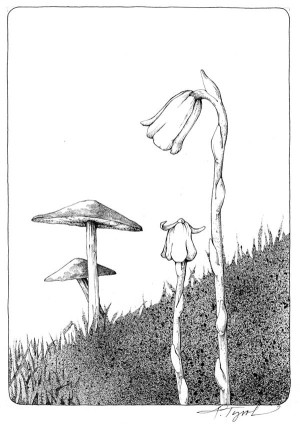
An oddity in the plant world is the roughly one percent of plant species that do not manufacture their own carbohydrates via photosynthesis. Instead, these plants are parasites, stealing carbohydrates from other plants. The northern woodlands are host to several species of parasitic plants, including Indian pipe, pine sap, beech drops, and squaw root.
The most common and easily recognized of the parasitic plants occurring in the northern woodlands is the Indian pipe (Monotropa uniflora). The name “Indian pipe” comes from the upside-down, pipe-like shape of the plant stem and its single, downturned, tube-shaped flower. The entire plant is a ghostly, waxy white or sometimes pinkish in color. This eerie coloration has given rise to another common name: corpse plant.
The flower stems of Indian pipe push through the duff of the forest floor in mid- to late summer, either singly or in small clusters. The virtually smooth stems, with tiny, vestigial leaves, grow to a height of 3 to 10 inches. The white pipes are conspicuous in the dense forest shade and grow where the light is too dim for most other plants to survive. Not much is known about the pollination of Indian pipe’s flowers, but the plant does produce copious, dust-like seeds. Upon fertilization, the downward-pointing flower turns upward, which is the reason behind the plant’s genus name of Monotropa, meaning “one turn.” After the seeds mature, the entire plant turns black but remains upright for up to several weeks.
Since Indian pipe does not photosynthesize, it does not need chlorophyll and so has no green coloration. It does not need leaves to gather sunlight, nor does it even need sunlight. What it does need, however, is to have its roots connected with an underground, mycorrhizal fungus that, in turn, is connected to the roots of a living tree. Symbioses between mycorrhizal fungi and photosynthesizing plants, such as trees, are common. The tree’s roots gather water and nutrients from the soil by way of the fungus, and the fungus takes carbohydrates that the tree has produced with energy from the sun. It is a mutually beneficial relationship. Indian pipe is an interloper in this symbiosis – stealing the tree’s carbohydrates from the fungus and giving nothing in return. Many scientists therefore consider Indian pipe to be a parasite of the fungus.
Indian pipe is a member of the heath (Ericaceae) family, along with mountain laurel, blueberry, and trailing arbutus. Scientists believe that Indian pipe descended from a photosynthesizing heath family plant of the forest understory. This ancestor plant probably shared the services of a mycorrhizal fungus with a tree, possibly a conifer. The ancestor plant was very efficient at tapping into the resources of the mycorrhizal fungus and began to confiscate the carbohydrates that the fungus had obtained from its conifer host. The ancestor plant became so efficient at stealing carbohydrates from the fungus that it no longer needed to photosynthesize. Over time, it lost its green coloration and its leaves and evolved into today’s Indian pipe.
Although Indian pipe produces many seeds, few seeds will germinate and grow on to become mature plants. This is because the dust-like seeds need very exacting conditions for germination and growth, including contact with the appropriate mycorrhizal fungus. Because Indian pipe is slow to establish from seed and thrives in deep shade, it is most often seen in older forests, especially those with rich soils.
Pine sap (Monotropa hypopithys) is a close relative of Indian pipe, with each stem supporting a cluster of nodding flowers. Its blooming season extends a few weeks beyond that of Indian pipe, into September. Early in the blooming season, pine sap tends to be a pale yellow color. But as autumn approaches, the plant can be infused with bright pink or red. Although both the common and species names associate this plant with pine (hypopithys means “under pine”), it does not require the presence of pine.
Beech drops (Epifagus virginiana), on the other hand, grow only in association with beech. The plant also blooms from late summer to early autumn, with branching, ascending, brownish tan stems that grow about 6 to 18 inches tall.
Finally there is squaw root (Conopholis americana), the early bird of this parasitic trio, which blooms from mid-spring to early summer. This stocky plant is yellowish brown and grows from 4 to 10 inches tall. Irregularly shaped flowers and fleshy, overlapping scales (the remnants of former leaves) hug the thick stems. A clump of squaw root looks a little like a group of pine cones pushing upward through the leaf litter. Squaw root grows in association with several species of oak.

